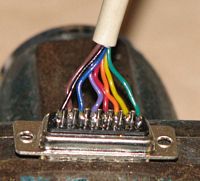Building the XP1541 Parallel Cable
- (1) DB15 male plug + hood
- (1) DB25 male plug + hood
- (1) 6' or 1.8 meters (max) 8 conductor unshielded cable (for parallel connection)
Visit the ports, parts & pinouts page for a descriptions of all the above parts.
Tools needed:
- Multi-meter with DIODE checker
- Soldering iron
- Solder
- Wire cutters
- Wire strippers
- Various screw drivers
- Small vice
- A lighted magnifier is very handy
This is a "parallel-only" cable, and it requires the use of a companion serial cable. It is compatible with newer parallel ports and newer modes like PS/2, ECP and EPP which have bidirectional data lines. You must have the C= parallel option installed in your disk drive in order to use this cable. Even though this is an easy cable to build, it has restricted usefulness as by itself it requires a system with two parallel ports, one for the XP1541 and one for any of the other serial cables (X, XE, XA, XM). Instead, it is recommended to get a combined Y form of this cable such as the XEP1541, XMP1541 or better yet the XAP1541. OS and software compatibility depends on the cable the XP1541 is combined with.
If you're not sure this is the right cable for you, see my cable picking guide to check.
Since I have not built one of these cables separately, the pictures and instructions below are taken from some of the other cable building instructions.
XP cable copyright Joe Forster/STA, 1997
Step 1: Prep the DB15 connector and attach the wires
- Strip one end of the 8 conductor cable back about 3/4" (2 cm) to expose the wires.
- Strip each wire back about 1/4" (5 mm).
- Twist and tin each wire.
- Pre-solder each DB15 cup from pin 1 to 8, so that wire insertion will be easier.
- Attach the 8 wires to pins 1 to 8 on the DB15. Mark down what wire color goes to what pin, for later use.
 |
| Wires attached to the DB15 |
Note that there is no ground line on this half of the cable. This cable depends on working with another serial cables, either an X, XE, XM or XA, which contains the ground line. Inclusion of a ground line here could cause a ground loop condition, something which must be avoided. Also, the parallel port add-on on the C= disk drive doesn't contain a ground line for this very reason.
Step 2: Prep the other end of the 8 conductor wire and attach to the DB25
- Strip the other end of the 8 conductor cable back about 3/4" (2 cm) to expose the wires.
- Strip each wire back about 1/4" (5 mm).
- Twist and tin each wire.
- Solder bridge pins 18 to 25 on the DB25 connector to make the ground strip. It may help to cut and bend a wire so it fits from pin 18 to 25 and solder it to the cups.
- Pre-solder the DB25 cups from pins 2 to 9.
- Attach each wire to the DB25, using the color code from the previous step on the DB15.
- DB15 to DB25 pins...
- 1 to 2
- 2 to 3
- 3 to 4
- 4 to 5
- 5 to 6
- 6 to 7
- 7 to 8
- 8 to 9
Step 3: Check the cable
- Using a multi-meter on DIODE (continuity) check, measure between the pins on the chart below. There should be a short between each of the pins from one connector to the other..
- DB15 to DB25 wires
- Verify that pins 18 through 25 on the DB25 are shorted together. Note that these are not connected to any other ground.
Cable pinout chart
DB15 (male) |
DB25 (male) |
|---|---|
1 (PB0) |
2 (DATA0) |
2 (PB1) |
3 (DATA1) |
3 (PB2) |
4 (DATA2) |
4 (PB3) |
5 (DATA3)
|
5 (PB4) |
6 (DATA4)
|
6 (PB5) |
7 (DATA5)
|
7 (PB6) |
8 (DATA6)
|
8 (PB7) |
9 (DATA7)
|
18 to 25 shorted |
Step 4: Finish the cable. Mount the DB ends in their hoods
- Mount both the DB15 and the DB25 connectors in their respective hoods. If the wires need to be squished a bit to fit, it should be OK to do so.
- Test the cable to make sure it works.
 |
Schematics drawn using ExpressPCB, a free and excellent solution which also supports PC board layout editing.
Email the author: Peter Schepers | Last updated: Mar 17, 2009
